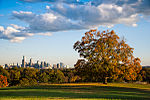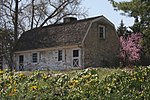Columbia Railroad Bridge
Bridges completed in 1920Bridges in PhiladelphiaBridges over the Schuylkill RiverCSX Transportation bridgesConcrete bridges in Pennsylvania ... and 2 more
Deck arch bridges in the United StatesRailroad bridges in Pennsylvania

Columbia Railroad Bridge, also known as "Columbia Bridge", is a 1920 concrete arch bridge in Philadelphia, Pennsylvania, that carries CSX Trenton Subdivision rail lines over the Schuylkill River. Located in Fairmount Park, upstream of the Pennsylvania Railroad Connecting Bridge, it is the third railroad bridge at the site. Near its east abutment are the Schuylkill Grandstand (for viewing rowing regattas) and the John B. Kelly statue.
Excerpt from the Wikipedia article Columbia Railroad Bridge (License: CC BY-SA 3.0, Authors, Images).Columbia Railroad Bridge
Schuylkill River Trail, Philadelphia
Geographical coordinates (GPS) Address External links Nearby Places Show on map
Geographical coordinates (GPS)
| Latitude | Longitude |
|---|---|
| N 39.985555555556 ° | E -75.203611111111 ° |
Address
Columbia Railroad Bridge
Schuylkill River Trail
19130 Philadelphia
Pennsylvania, United States
Open on Google Maps











